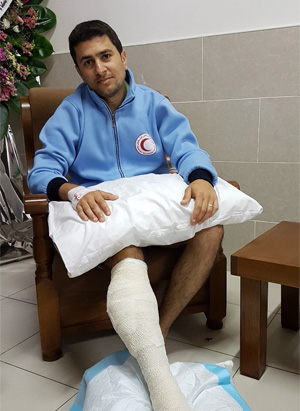
April 2018, Gaza –Imad is 34 and has been volunteering as a first responder with the Palestinian Red Crescent Society (PRCS) since 2006. On Monday 9 April 2018, Imad volunteered with PRCS east of al Bureij refugee camp in the Middle Area of the Gaza Strip. Imad was waiting as part of the PRCS team, sitting in the front passenger seat of an ambulance beyond the 300-metre zone.
“Just after 5 o’clock there was suddenly shooting from the barrier and I was hit in my right leg. We got out of the ambulance straight away and went to hide behind it [on the opposite side from the Gaza barrier]. At this point the paramedics who were with me put a bandage on my leg to stem the bleeding and then they got me into the ambulance and moved me to Al Aqsa Hospital in Deir Al-Balah. I was in Al Aqsa Hospital for about 30 minutes to receive first aid and then I was moved to Al-Quds Hospital in Gaza City. From there they transferred me to Shifa Hospital after the doctors diagnosed me with compartment syndrome [bleeding into the calf of the leg that then cuts off the blood supply to the leg]. In Shifa I had surgery. Doctors told me that if I hadn’t been able to have this surgery I would have lost my leg.”
Imad has been volunteering with PRCS for more than 10 years. He reports that the teams he works with are often exposed to tear gas and he himself has previously sustained some minor injuries. However, Imad remains committed to volunteering with the ambulances and first responders.
“We need humanitarian workers in this difficult situation. Gaza has been exposed to three wars in 6 years. Life here is a constant emergency. Working with PRCS to help the sick and injured, you feel at least that you are able to improve things in some small way.”
Imad graduated in English from Al-Azhar University in Gaza in 2008. He works intermittently as an emergency trainer for the PRCS and other organizations. He is married and has 2 young children.
Now Imad is recovering from this initial operation at Al Quds Hospital in Gaza City. He is due for a second operation to remove the bullet, which is still lodged in his right calf muscle, and to fix a fracture. “After I complete my treatment and get better, I’m aiming to go back to working with the ambulances. For me, it’s a duty that I feel to our patients and to Gaza.”


